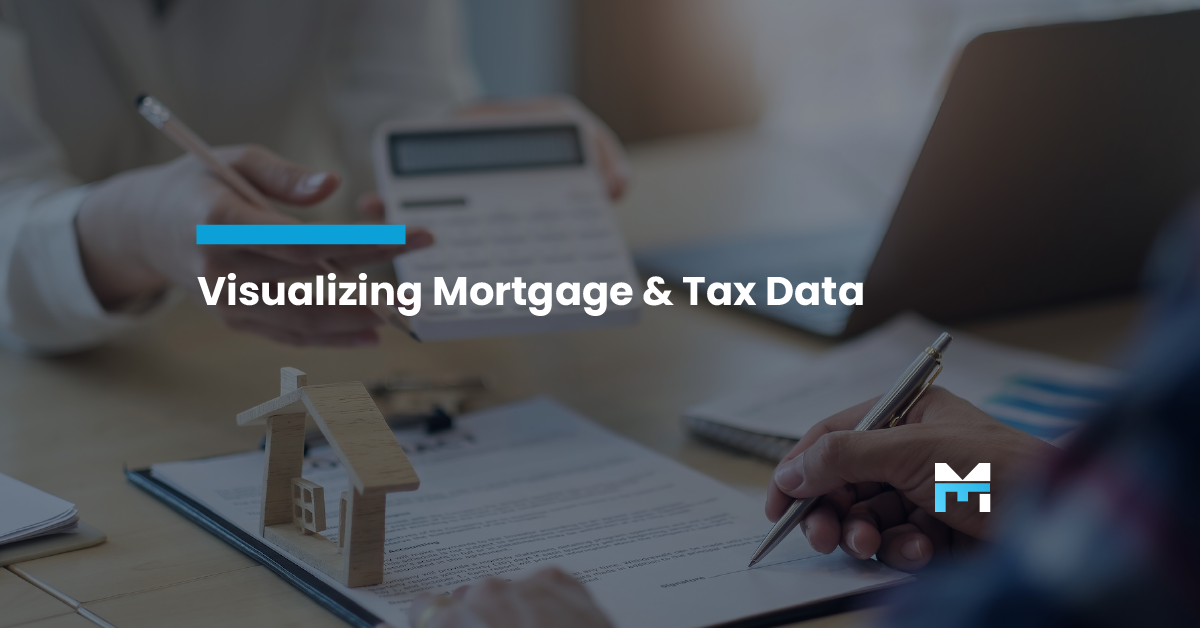5 min read
Visualizing Combined Tax and Mortgage Payment Trends for Clients
Justin Kirsch : Nov 4, 2025 10:00:00 AM

For most people, buying a home is the biggest financial decision they’ll ever make. It's a journey filled with excitement, but also a fair amount of anxiety. Much of that stress comes from trying to understand the long-term financial commitment, which goes far beyond just the principal and interest on a loan. Property taxes, for instance, are a significant, recurring expense that can fluctuate and catch homeowners off guard if they aren't prepared.
As a mortgage professional, how do you effectively communicate this total cost to your clients? How do you move beyond dense spreadsheets and long columns of numbers to provide a clear, intuitive picture of their future financial obligations? The answer lies in the power of data visualization. By creating dynamic, interactive charts that combine mortgage payments and property tax trends, you can transform a complex and often intimidating topic into an easily digestible and empowering experience for your clients.
This guide will explore how to leverage powerful tools, particularly within the Microsoft ecosystem, to create these visualizations. We'll show you how this approach not only enhances client understanding and trust but also streamlines your workflow, positioning your firm as a modern, tech-forward partner. This builds on the foundation we discussed in our previous blog, The Mortgage Tech Ecosystem Playbook: How to Build Systems That Scale, Automate, and Deliver, by demonstrating a practical application of a well-integrated tech stack.
Table of Contents
- Why Your Clients Need to See the Big Picture
- Building the Visualization: A Practical Approach
- Harnessing the Power of Microsoft Tools
- The Benefits of a Visual-First Strategy
- Your Next Step Toward a Modern Mortgage Experience
- Key Takeaways
- Frequently Asked Questions
Why Your Clients Need to See the Big Picture
A standard loan amortization schedule is useful, but it tells only part of the story. It shows how the loan balance decreases over time, but it often treats property taxes as a static line item, if it includes them at all. The reality is that property taxes are dynamic. They can increase due to rising property values or changes in local millage rates, significantly impacting a homeowner's total monthly payment.
When clients don't fully grasp this, it can lead to confusion, frustration, and even financial distress down the line. Imagine a client whose monthly payment unexpectedly jumps by a few hundred dollars because of an escrow shortage caused by a tax hike. That's a difficult conversation to have and one that can erode the trust you've worked so hard to build.
By visualizing the combined trends of mortgage and tax payments, you preempt these issues. An interactive chart allows a client to see:
- How their total payment is allocated between principal, interest, and taxes.
- The projected impact of a potential tax increase over several years.
- How their principal balance declines even as their total payment might fluctuate.
This transparency doesn't just educate; it empowers. It helps clients plan for the future with confidence and solidifies your role as a trusted advisor who has their best interests at heart.
Building the Visualization: A Practical Approach
Creating an effective visualization doesn't require a degree in data science, but it does require a structured approach. You can build a powerful tool for your clients by following a few key steps.
First, gather the necessary data. This includes the loan amount, interest rate, loan term, and an estimated or historical property tax amount. For added value, you can research historical property tax data for the specific area to project potential future increases.
Next, structure your data in a way that can be easily charted. A Microsoft Excel spreadsheet is a perfect starting point. You'll want columns for each payment period (usually monthly) showing the breakdown of the payment: principal, interest, taxes, and the total payment. You should also include a column for the remaining loan balance.
The core of your visualization will be a dynamic chart. A stacked area chart or a combination line-and-area chart works well. You can show the principal and interest payments as stacked areas, with a separate line illustrating the projected tax payments over the life of the loan. This instantly shows the relationship between the different components of the monthly payment.
Harnessing the Power of Microsoft Tools
While a well-crafted Excel chart is a great start, the Microsoft Power Platform offers tools to take your data visualization to the next level, creating truly interactive and scalable solutions.
Microsoft Excel
For many, Excel is the go-to tool for financial modeling. You can create a detailed amortization schedule that factors in property taxes. By using "What-If" scenarios, you can add sliders or input cells that allow clients to adjust variables like the loan amount, interest rate, or an assumed annual tax increase, and see the chart update in real-time. This turns a static report into an engaging, hands-on planning tool.
Microsoft Power BI
For a more robust and professional presentation, Microsoft Power BI is the gold standard. You can connect Power BI directly to your Excel models or other data sources. Power BI allows you to build a dynamic loan calculator dashboard. As detailed in the Microsoft Fabric Community, you can create "What-If" parameters for the credit amount, loan term, and interest rate. By extending this concept, you can add another parameter for the property tax rate.
Imagine sitting with a client and adjusting slicers on a screen:
- Slide the "Annual Tax Increase" from 2% to 4% and watch the total payment line on the chart adjust accordingly.
- Change the loan term from 30 years to 15 years and see the entire amortization schedule recalculate instantly.
This level of interactivity makes complex financial concepts tangible and easy to understand, providing immediate, real-time financial insights.
Microsoft Fabric
For larger firms looking to scale their data operations, Microsoft Fabric provides an all-in-one analytics solution. It integrates everything from data movement to data science and real-time analytics. In the context of our mortgage visualization, Fabric could be used to pull in property tax data from multiple public sources, standardize it, and feed it into a company-wide Power BI dashboard available to all your loan officers. This ensures consistency and accuracy across your entire organization.
The Benefits of a Visual-First Strategy
Adopting a visual approach to explaining complex mortgage data offers significant advantages for your firm:
- Enhanced Client Comprehension: Visuals are processed faster and retained longer than text or raw numbers. A chart can communicate in seconds what might take pages of tables to explain.
- Increased Trust and Transparency: When you openly show clients how all the numbers work, including potential tax increases, you build a foundation of trust. You're not hiding anything; you're preparing them for reality.
- Competitive Differentiation: In a crowded market, providing a superior client experience is a powerful differentiator. Offering interactive, easy-to-understand financial visualizations sets you apart from competitors who are still relying on static PDF reports.
- Improved Efficiency: Once you build a template in Excel or Power BI, you can reuse it for every client. This automates a key part of the client education process, saving your team valuable time.
Your Next Step Toward a Modern Mortgage Experience
Explaining the intricacies of a mortgage, complete with the variable nature of property taxes, is a challenge. But with the right tools and a commitment to clarity, you can turn this challenge into an opportunity to build stronger, more trusting relationships with your clients. Visualizing data isn't just about making things look pretty; it's about fundamentally changing how you communicate complex information.
The future of the mortgage industry belongs to those who effectively integrate technology to automate processes and deliver superior client value. Visualizing mortgage and tax data is a perfect example of this principle in action.
Are you ready to transform your client consultations and build a more efficient, modern mortgage practice? The technology is here, and the path is clear. Partnering with an expert like Mortgage Workspace can accelerate your journey. We specialize in building custom, scalable tech solutions for the mortgage industry, leveraging the full power of tools like Microsoft Power BI and the Power Platform to help you succeed.
Let's build a system that empowers your clients and grows your business. Contact Mortgage Workspace today to schedule a consultation.
Key Takeaways
- Visualizing combined mortgage and property tax data provides clients with a clear, complete picture of their long-term financial commitment.
- Tools like Microsoft Excel and Power BI allow you to create dynamic, interactive charts that make complex financial information easy to understand.
- A visual-first approach enhances client trust, improves operational efficiency, and provides a significant competitive advantage.
- Integrating data visualization is a practical step toward building a modern, scalable mortgage tech ecosystem.
Frequently Asked Questions
- Do I need to be a tech expert to create these visualizations?
Not at all. While advanced dashboards in Power BI may have a learning curve, you can create highly effective and interactive charts in Microsoft Excel with basic formula and charting skills. The key is to start simple and build on your success. - How do I get accurate property tax data?
For initial estimates, you can use the tax information from the property listing or local government tax assessor websites. For creating future projections, you can analyze historical tax rate changes for the specific municipality to establish a reasonable expected growth rate. - Can this visualization be integrated with our existing CRM or loan origination software?
Yes. More advanced solutions using Microsoft Power BI and Fabric can be designed to integrate with various data sources, including CRMs and loan origination systems. This allows for seamless data flow and ensures your visualizations are always populated with the most current client information.

The Economics of Mortgage Loan Platforms: Subscription vs. Transaction Pricing
The mortgage industry stands at a crossroads. While traditional lenders cling to outdated pricing models, forward-thinking companies are discovering...


